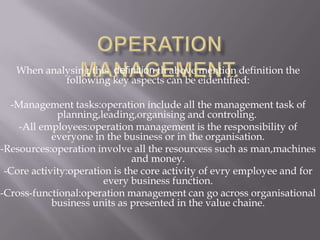
Operation management
- 1. When analysing this definition th above mention definition the following key aspects can be eidentified: -Management tasks:operation include all the management task of planning,leading,organising and controling. -All employees:operation management is the responsibility of everyone in the business or in the organisation. -Resources:operation involve all the resourcess such as man,machines and money. -Core activity:operation is the core activity of evry employee and for every business function. -Cross-functional:operation management can go across organisational business units as presented in the value chaine.
- 2. System approach to operation management. A system approach implicates that the organisation is the system and the organisation is the open system.In the open system all the sub- system work together or move towards working for the common goal of the total system.In the operationall the inputs that ar tranformed into the outputs are exposed to the various subsystem.All subsystem must work together to achieve the common goal or the common purpose of the organisation.
- 3. Characteristics of operation management. The volume characteristics of operation management. The volume dimention refers to the volume of the product or service its self. Provides Quantitative Answers The solutions found by using operations research are always quantitative. OR considers two or more options and emphasizes the best one. The company must decide which option is the best alternative for it. Human Factors In other forms of quantitative research, human factors are not considered, but in OR, human factors are a prime consideration. People involved in the process may become sick, which would affect the company's output. New Problems Revealed Finding a solution to a problem in OR uncovers additional problems. To obtain maximum benefits from the study, ongoing and continuous research is necessary. New problems must be pursued immediately to be resolved.
- 4. Objectives of Production or operation Function 1. To produce goods and services as per the estimated manufacturing cost and minimum inputs of resources. 2. To produce right quality goods and services as per the established standards and specifications. 3. To produce goods and services as per the decided time schedule. 4. Minimize the use of resources to the optimum level. These are 4 M's :- like Machinery, Materials, Manpower and Money. These inputs are to be used to full extent to result minimum cost, quality and time. 5. Maximize the utilization of manpower. 6. Minimizing the total cost of production with continuous elimination of non-value added activities and improwing labour productivity on the production shop floor.
- 5. Responsibility of operation manager The responsibilities of an operations manager involves the process of planning, designing, and operating production systems and subsystems. Most managers have operations management responsibilities; these include product design, facility location, facility design and layout, quality assurance, materials management and inventory control, scheduling, and maintenance planning. When managing warehouse or transport staff, the role may also include: Implementing health and safety procedures Managing staff training issues Motivating other members of the team Project management
- 6. Activity Sequencing The Activity Sequencing process involves the identification and documentation of the logical relationships among schedule activities. Schedule activities can be logically sequenced with appropriate precedence relationships, leads and lags to enable a realistic, achievable project schedule. Sequencing may be performed using project management software and/or manual techniques.
- 7. Constraints on the planning and control task In any operation the supply of resources is not infinite. Consider the planning and control of a music concert. The electrical work for the concert could be performed in a few hours if several hundred electricians all arrived and set about the task simultaneously, but this would be more expensive than using a smaller number over a longer time. There might also be a physical constraint on how many electricians are available in the time. Even with an infinite budget, if there are only ten electricians available to do the work within the time period, then that is the limit on the number which can be hired. There will also be constraints imposed by the quality of what is required by the concert promoters.
- 8. Planning and controlling Planning and control are different but very closely related. Planning is the theoretical end of the activity, while control is the more applied end. Planning involves deciding what to do and when to do it. Control involves making sure that plans are actually taking place in practice and responding when things do not according to plan. Planning looks at activities sometime in the future. Control looks at activities that are happening now. (Of course ‘now’ can mean this minute, this hour, today, this week, this month, etc. It is all relative). The point being that there is an immediacy about control that is not there in planning. However, because control involves taking circumstances into account and re- planning, control inevitably involves making plans (or more accurately, making new plans).
